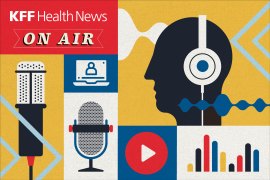Longer Looks: Interesting Reads You Might Have Missed
KFF Health News finds longer stories for you to spend some time with over the long weekend. Today's selections are on chronic disease, hearing loss, a gonorrhea vaccination program, and more.
The New York Times:
Is There Really A Chronic Disease Epidemic? It’s Complicated
Robert F. Kennedy Jr., the health secretary, often says that when his uncle was president in the early 1960s, Americans were much healthier than they are now. People were thinner and had lower rates of chronic disease, he recalls. Fewer children had autism, allergies or autoimmune diseases. On Thursday, the Trump administration released a report on children’s health premised on the idea that we’ve fallen far since this golden era. But were Americans really healthier back then? (Caryn Rabin, 5/22)
The New York Times:
Your Hearing Can Get Worse as You Age. Here’s How to Protect It.
It can be difficult to tell whether your environment is noisy enough to cause damage, but there are signs to watch for: If you need to shout to speak to someone a few feet away, your hearing is probably at risk, according to O.S.H.A. Many smartphones and watches can also alert you if your surroundings reach potentially harmful volumes, said Patricia Gaffney, president of the American Academy of Audiology. The same goes for the volume of music in your headphones. (Mogg, 5/15)
The New York Times:
Why Boys and Men Are Floundering, According to the Relationship Therapist Terry Real
A session with Terry Real can be uncomfortable. The marriage and family therapist is known to mirror and amplify the feelings of his clients — sometimes cursing and nearly yelling — in an attempt to get men in touch with emotions they’re not used to expressing. Real says men are often pushed to shut off their expression of vulnerability when they are young. That process, he says, can lead to myriad problems in their future relationships. Real recently joined Anna Martin, host of the Modern Love podcast, to discuss his work, why he thinks our current models of masculinity are broken and what it will take to build new ones. (5/14)
Stat:
Energy Drinks Rebrand As Wellness, Add Women To Bro-Heavy Market
The energy drink cans are the colors of a tropical beach sunset — aqua and tangerine and neon pink — so they really pop when lined up for fridge organizing shots on TikTok. They’re sugar-free but come in summery dessert flavors like Sherbet Swirl. On social media, the drinks are brandished by members of an official collegiate ambassadors program, gymnasts and cheerleaders whose dewy complexions suggest they’ve never had a hangover or slept through their alarm after a late-night study session. (Todd, 5/13)
From around the nation —
Los Angeles Times:
Many Fire Cleanup Workers Are Not Protecting Against Toxic Debris
A new study shows that only a quarter of fire cleanup workers in Altadena wore gloves, a fifth wore a protective mask, and a mere tenth donned full Tyvek suits, as required by California’s fire cleanup regulations. For Pablo Alvarado, co-executive director and co-founder of NDLON, the results aren’t surprising. (Haggerty, 5/22)
CIDRAP:
England To Begin Vaccination Program To Prevent Gonorrhea
England's National Health Service (NHS) announced today that it is set to launch a vaccination campaign against gonorrhea this summer. Starting in early August, eligible patients, including gay and bisexual men who have a recent history of multiple sexual partners or a sexually transmitted infection (STI), will be able to receive an existing vaccine for meningococcal B disease (4CMenB) at local authority-commissioned sexual health clinics to prevent gonorrhea. (Dall, 5/21)
North Carolina Health News:
Up in smoke: Federal cuts threaten to derail NC’s progress on tobacco prevention
The loss of key CDC funding is a blow that public health leaders warn could unravel years of progress in a state long tied to Big Tobacco. (Baxley and Hoban, 5/21)
Parting words —
NPR:
A Top Global Health Expert's Message To Graduates: Kick The Tires
Maria Van Kerkhove knows how to operate under stress. As an epidemiologist and key leader at the World Health Organization during the pandemic, she was at the forefront of trying to combat the ever-changing pandemic. She served as the face of WHO in over 250 media briefings, explaining to the world what scientists were learning about the latest variant and how much sickness and death it might cause. (Lambert, 5/22)






